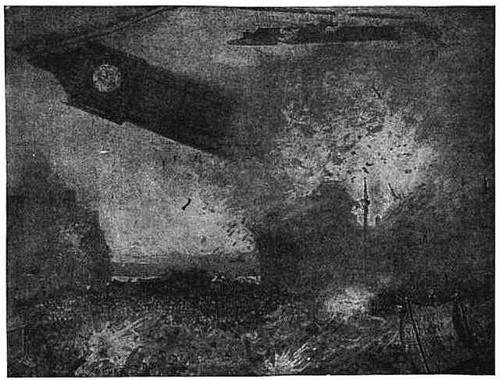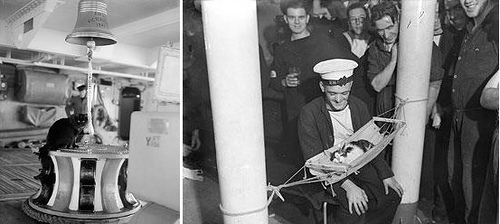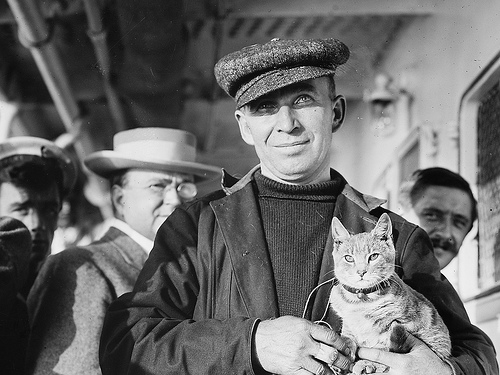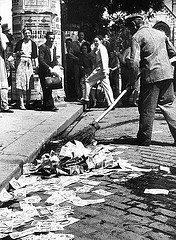My infant son rules his mother.
His mother rules me.
I rule the Athenians.
The Athenians rule the Greeks.
The Greeks rule Europe.
And Europe rules the world.
Thus my infant son rules the world.
My infant son rules his mother.
His mother rules me.
I rule the Athenians.
The Athenians rule the Greeks.
The Greeks rule Europe.
And Europe rules the world.
Thus my infant son rules the world.
Dubious but colorful: The Foreign Quarterly Review, January 1844, reports the case of Quatremer Disjonval, a Dutch adjutant-general whom the Prussians had incarcerated in a dungeon at Utrecht.
To pass the time he studied the prison’s spiders and noted that their behavior varied with approaching weather. When a sudden thaw threatened the advance of republican troops in January 1795, Disjonval sent a letter to the French general promising a severe frost within two weeks.
When the cold that arrived 12 days later froze Dutch canals solid enough to bear French artillery, the republicans took Utrecht and “Quatremer Disjonval, who had watched the habits of his spiders with so much intelligence and success, was, as a reward for his ingenuity, released from prison.”
Commandant Louis Joseph Lahure has a singular distinction in military history — he defeated a navy on horseback.
Occupying Holland in January 1795, the French continental army learned that the mighty Dutch navy had been frozen into the ice around Texel Island. So Lahure and 128 men simply rode up to it and demanded surrender. No shots were fired.
“It is astonishing that there should still be found today people who do not believe that there are witches.” — Henry Bouget, 1602

E. Douglas Fawcett’s 1893 story “Hartmann the Anarchist” described an aerial bombardment of London — 47 years before World War II:
With eyes riveted now to the massacre, I saw frantic women trodden down by men; huge clearings made by the shells and instantly filled up; house-fronts crushing horses and vehicles as they fell; fires bursting out on all sides, to devour what they listed, and terrified police struggling wildly and helplessly in the heart of the press.
Hartmann rains dynamite bombs, shells, and blazing petroleum from his airship before a mutiny brings him down. “It has not been my aim to write history,” writes the narrator. “I have sought to throw light only on one of its more romantic corners.”
See also Wreck of the Titan and A Blindfold Bullseye.

British sailors had some furry help during World War II. Tiddles (left) spent his whole life aboard Royal Navy aircraft carriers, traveling some 30,000 miles with them. He was born at sea on HMS Argus and was later promoted to captain’s cat on HMS Victorious. He’s pictured in July 1942 at his favorite station, on the after capstan, where he could play with the bellrope.
Convoy, the ship’s cat on HMS Hermione, was so named because he often accompanied the ship on convoy escort duties. He was listed in the ship’s book and given a full kit, including his own hammock. He went down with 87 of his shipmates when the Hermione was torpedoed in 1942.
“In a cat’s eyes,” runs an English proverb, “all things belong to cats.”

On Oct. 15, 1910, the airship America took off from Atlantic City in a bid to cross the Atlantic. The six crewmembers took along a cat, Kiddo, for luck.
The frightened tabby was still underfoot when chief engineer Melvin Vaniman tried to send a historic wireless message back to shore. So officially the first radio communication ever made from an airship in flight was:
“Roy, come and get this goddamn cat.”

You might have had trouble making change in postwar Hungary — the national currency, the pengo, was plunging so quickly in value that prices doubled every 15 hours.
To simplify calculations, the government eventually introduced a banknote worth 100 quintillion pengo. It was worth 20 American cents.
Things only got worse. By July 1946, the monthly inflation rate had reached 41,900,000,000,000,000 percent, and, unbelievably, the combined value of all Hungarian banknotes equaled one-thousandth of a U.S. dollar.
In desperation the government gave up and introduced a new currency, the forint. In the end you could get 1 new forint by trading in 400,000,000,000,000,000,000,000,000,000 (400 octillion) pengo.
That’s the all-time record for hyperinflation — but modern Zimbabwe is not far behind. In fact, because Hungary couldn’t fit all 20 zeroes on that banknote, the 2006 Zimbabwean bill below holds the record for depicted zeroes on a national currency.

World War II ended in 1990.
When the Reich surrendered in 1945, there was no single German state for the Allies to negotiate with. So officially the war continued for 45 more years; the final treaty was signed when Germany reunified.
See also Burying the Hatchet.
In 1805, during his return from India, the Duke of Wellington stayed briefly in a house on the remote island of St. Helena in the South Atlantic.
By an odd coincidence, when Wellington defeated Napoleon at Waterloo 10 years later, the deposed emperor was exiled to the very same house — while Wellington occupied his former palace.
“You may tell Bony,” the duke wrote to a friend, “that I find his apartments at the Elisée Bourbon very convenient, and that I hope he likes mine at Mr. Balcom’s. It is a droll sequel enough to the affairs of Europe that we should change places of residence.”